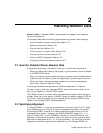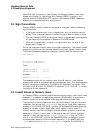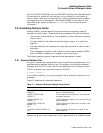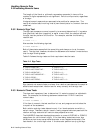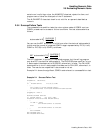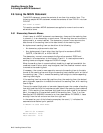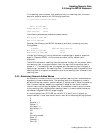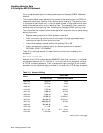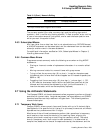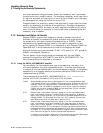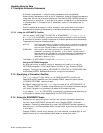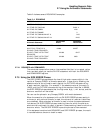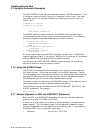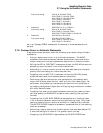
Handling Numeric Data
2.6 Using the MOVE Statement
Table 2–3 (Cont.) Numeric Editing
FLD-B
TOTAL-AMT
PICTURE String Contents After MOVE
-6543^21 $,$$$,$$$.99DB $6,543.21DB
1
1
The output includes DB if a negative value is moved.
The currency symbol ($ or other currency sign) and the editing sign control
symbols (+ and –) are the only floating symbols. To float a symbol, enter a string
of two or more occurrences of that symbol, one for each character position over
which you want the symbol to float.
2.6.3 Subscripted Moves
Any item (other than a data item that is not subordinate to an OCCURS clause)
of a MOVE statement can be subscripted, and the referenced item can be used to
subscript another name in the same statement.
For additional information, see Section 3.6.4, Subscripted Moves in Chapter 3,
Handling Nonnumeric Data.
2.6.4 Common Move Errors
Programmers most commonly make the following errors when writing MOVE
statements:
• Placing an incorrect number of replacement characters in a numeric edited
item
• Moving nonnumeric data into numeric items with group moves
• Trying to float the currency sign ( $ ) or plus ( + ) insertion characters past
the decimal point to force zero values to appear as .00 instead of spaces (use
$$.99 or .99)
• Forgetting that the currency sign ( $ ), plus sign ( + ), minus sign ( – ), CR,
or DB insertion characters require one or two additional positions on the
leftmost end that cannot be replaced by a digit (unlike the asterisk ( * )
insertion character, which can be completely replaced)
2.7 Using the Arithmetic Statements
The Compaq COBOL arithmetic statements allow programs to perform arithmetic
operations on numeric data. Large values present various problems, and COBOL
command qualifiers can help resolve or mitigate them. The following sections
discuss these topics.
2.7.1 Temporary Work Items
Compaq COBOL allows numeric items and literals with up to 31 decimal digits
(see Appendix A for specific limits). Hence it is quite easy to construct arithmetic
expressions that produce more than 31 digits.
Most forms of the arithmetic statements perform their operations in temporary
work locations, then move the results to the receiving items, aligning the
decimal points and truncating or zero-filling the resultant values. The actual
size of a temporary work item varies for each statement; it is determined at
compile time, based on the sizes of the operands used by the statement and the
Handling Numeric Data 2–9



